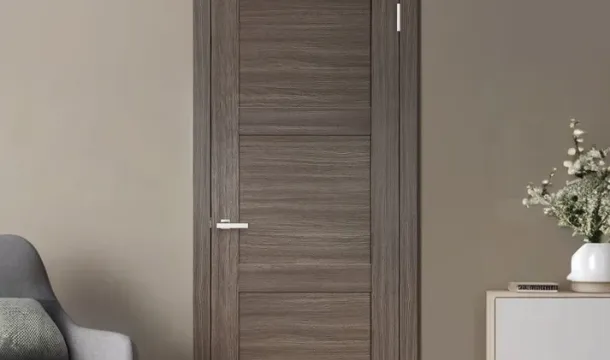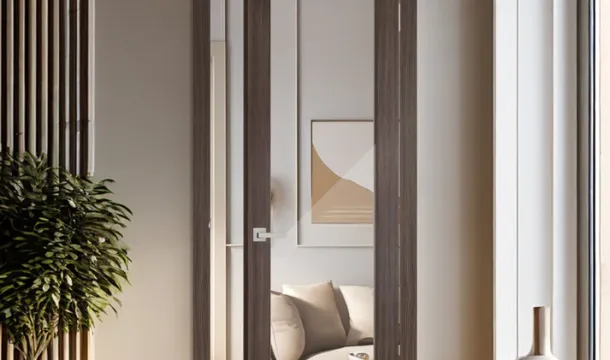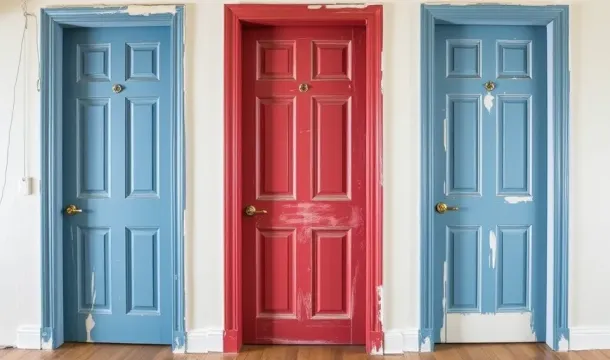Impact of Interior Doors on Space and Flow in Small Apartments
Popular Articles
- Choosing the Perfect Interior Doors for Your Canadian Home
- A Complete Guide to Choosing Interior Doors for Canadian Homes
- The Challenges of Painting Interior Doors
- Understanding Interior Doors and Their Role in Your Home
- The Perfect Blend of Reliability and Design: Interior Doors with Italian "Sandwich" Technology
Sliding or pocket doors save up to 10 square feet of usable floor area compared to traditional swinging doors, making them ideal for compact apartments. Choosing doors that slide inside walls or along them maintains clear pathways, improving movement between rooms without sacrificing precious space.
Glass-paneled interior doors enhance natural light penetration by up to 30%, visually expanding tight areas while preserving privacy. Frosted or textured glass options balance openness with discretion, contributing to an airy atmosphere that reduces the feeling of confinement common in small layouts.
Door width and placement directly influence apartment flow: narrow doors under 28 inches can cause bottlenecks, whereas wider openings facilitate smoother transitions. Positioning doors away from high-traffic zones minimizes interruptions, allowing furniture arrangement flexibility and optimizing circulation patterns.
Selecting minimalistic frames and flush designs reduces visual clutter, increasing perceived room size. Matte finishes prevent glare and complement various interior styles without overwhelming limited surfaces. Prioritizing multifunctional door solutions aligns with smart spatial strategies tailored for urban Canadian living spaces.
Choosing Door Types for Space
Selecting the right door type directly impacts usable floor area and circulation in small apartments. Sliding doors are optimal when wall space is limited, as they eliminate swing radius and allow furniture placement closer to openings. For rooms under 100 square feet, pocket doors that recess into the wall save up to 10 square feet compared to conventional hinged doors.
Bi-fold doors offer a compromise between full swing and sliding options, folding neatly without requiring full clearance. They work well for closets or laundry areas where partial access suffices. Avoid traditional hinged doors with wide swings in narrow corridors narrower than 36 inches, as they can obstruct movement and reduce functional width.
Material and Transparency Impact
Glass-paneled interior doors with slim frames improve natural light flow, making compact spaces feel larger without sacrificing privacy if frosted or textured glass is used. Lightweight materials like hollow-core composite reduce installation strain on thin walls common in small units.
Hardware and Installation Considerations
Soft-close mechanisms prevent slamming in tight layouts and extend hardware lifespan. Floor-mounted tracks for sliding systems maximize ceiling height usage but require precise installation to avoid operational issues. Wall-mounted rails offer easier retrofit options without structural changes.
In summary, prioritize door types minimizing swing interference and enhancing light transmission while matching existing wall thicknesses and finishes. This approach preserves space efficiency and supports smooth traffic flow throughout small apartment interiors.
Maximizing Natural Light Access
Install interior doors with large glass panels or frosted glass inserts to allow light to flow between rooms while maintaining privacy. For small apartments, choosing doors with translucent materials can increase daylight penetration without sacrificing separation of spaces.
Sliding or pocket doors with glass components minimize obstruction in doorways and enable uninterrupted natural light pathways. Unlike solid doors that block light entirely, glass-paneled doors create visual connectivity and expand the perception of openness.
Placement and Orientation Strategies
Positioning doors opposite windows or sources of natural light enhances cross-room illumination. Aligning doorways to capture sunlight from adjacent spaces reduces reliance on artificial lighting during daytime hours.
Material and Finish Choices
Light-colored frames and reflective finishes around door edges amplify ambient light reflection. Avoid dark wood or matte finishes that absorb rather than bounce light. Opt for slim-profile frames to maximize glazed surface area without compromising structural integrity.
Improving Movement with Door Placement
Positioning interior doors to align with natural walking paths reduces unnecessary detours and congestion in small apartments. Avoid placing doors directly opposite each other in narrow corridors, as this creates bottlenecks and limits simultaneous passage.
For rooms that serve multiple functions, such as combined living and dining areas, offset doorways by at least 30 centimeters from the centerline. This allows furniture placement without obstructing access and encourages fluid movement.
Key Strategies for Optimal Door Placement
- Corner Positioning: Installing doors near corners rather than mid-wall frees up wall space for storage or seating while streamlining circulation routes.
- Sliding and Pocket Doors: Incorporate sliding or pocket doors where possible to eliminate swing radius conflicts in tight spaces, enabling direct passage between rooms.
- Staggered Entries: Stagger entrances to adjacent rooms instead of aligning them on a single axis, which prevents cross-traffic clashes and enhances privacy.
Examples of Efficient Door Layouts
- A bedroom door positioned adjacent to the closet entrance minimizes hall traffic crossing paths with sleeping areas.
- An entryway door offset from the kitchen doorway avoids crowding during meal preparation times.
- A bathroom door opening into a hallway corner rather than centrally reduces interference with main circulation zones.
Evaluating daily movement patterns before finalizing door locations can reveal opportunities for smoother transitions, better space utilization, and fewer obstacles. Mapping out these flows visually helps identify problematic intersections early in design stages.
Popular Articles
- Choosing the Perfect Interior Doors for Your Canadian Home
- A Complete Guide to Choosing Interior Doors for Canadian Homes
- The Challenges of Painting Interior Doors
- Understanding Interior Doors and Their Role in Your Home
- The Perfect Blend of Reliability and Design: Interior Doors with Italian "Sandwich" Technology

Choosing the Perfect Interior Doors for Your Canadian Home

A Complete Guide to Choosing Interior Doors for Canadian Homes
